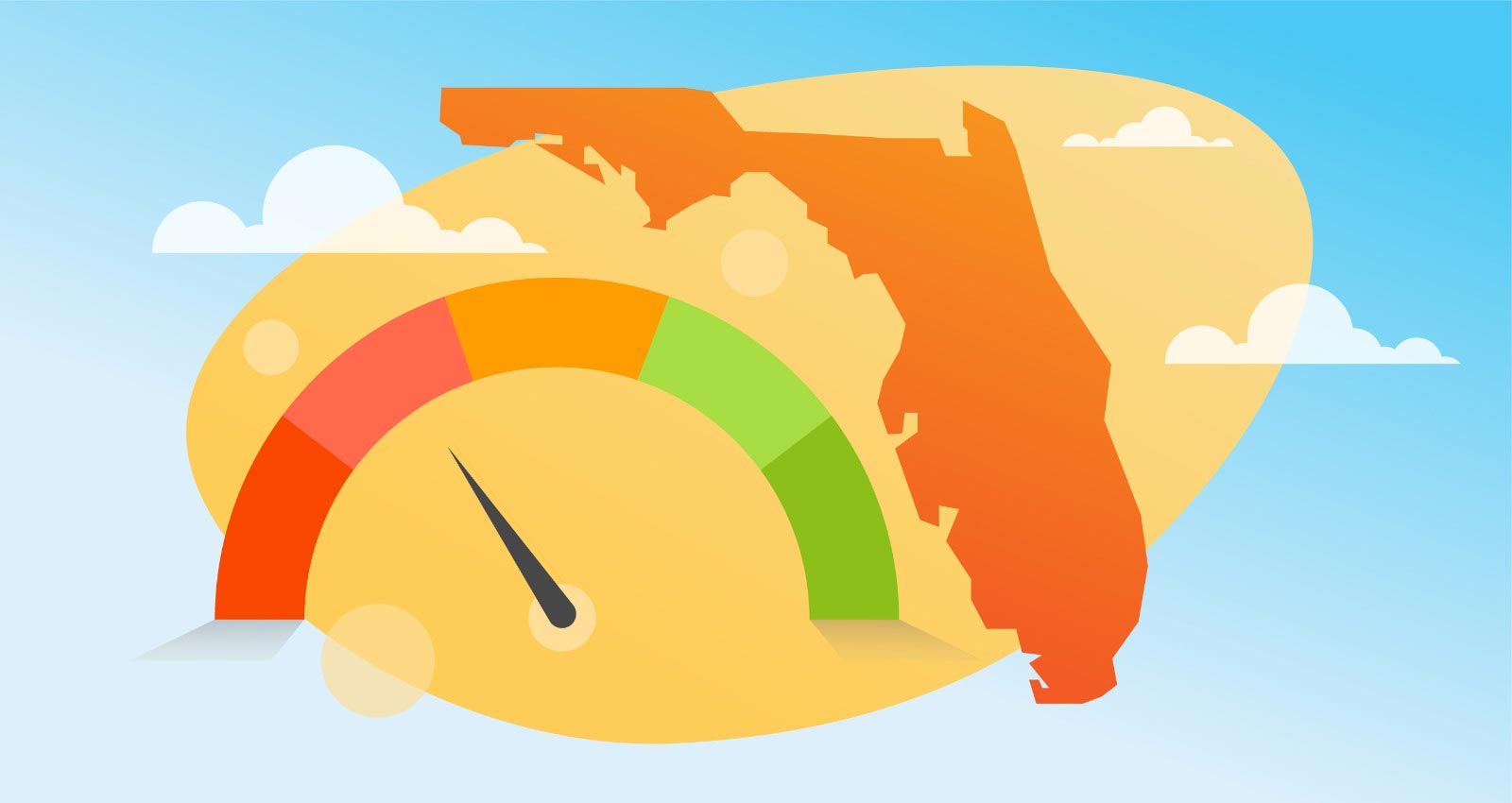
The average credit score in Florida is 680. Between the corporate center of Tampa, the vacation wonderland of Orlando, the swamps of the Everglades, the spring training baseball heaven of Clearwater and laid-back Key West, Florida’s fiscal behavior is as diverse as its population. Let’s explore the financial landscape of Florida.
Key statistics
- Florida’s average credit score is 680. The national average is 690.
- The average Vantage score in Florida has varied by 47 points over the last five years. The high was 707 in 2016 and the low was 660 in 2015.
- Total student loan debt for the state of Florida in 2021 totals $94 billion. The average Florida student carries $39,700 in student loan debt. [18] Student Loan Debt by State https://educationdata.org/student-loan-debt-by-state#florida The total student loan debt nationally is $1.6 trillion. [17] Student Loan Debt Statistics https://educationdata.org/student-loan-debt-statistics
- Florida’s average level of credit card debt is consistently above the national average. The credit card balance of the average American is $6,194. The average Floridian’s credit card balance is $$6,460. [19] Average American Credit Card Debt by State https://www.cnbc.com/select/average-credit-card-balance-by-state/
- Homeowners in Florida have the eighth highest rate of mortgage delinquencies at 1.47 percent. The national mortgage delinquency rate is 7.65 percent. [20] Mortgage Delinquencies Decrease in the Third Quarter of 2020 https://www.mba.org/2020-press-releases/november/mortgage-delinquencies-decrease-in-the-third-quarter-of-2020
Florida’s Credit Score Over Time
| Year | Average Vantage Score - FL |
|---|---|
| 2015 | 660 |
| 2016 | 707 |
| 2017 | 672 |
| 2018 | 674 |
| 2019 | 674 |
| 2020 | 680 |
How Credit Scores in Florida Compare to Other States
| Year | Average Vantage Score - FL | Average Vantage Score - US |
|---|---|---|
| 2015 | 660 | 672 |
| 2016 | 707 | 726 |
| 2017 | 680 | 678 |
| 2018 | 672 | 678 |
| 2019 | 672 | 684 |
| 2020 | 680 | 690 |
Although Florida’s credit scores are slightly lower than the national average, Florida’s trend line seems to follow the national average pretty closely by a few points. As of 2020, Florida has the 15th lowest ranked average Vantage score in the United States with a score of 680. Interestingly, Florida also shares the distinction with Alaska as being two out of the top ten states whose residents rely the most on credit. [1] 10 States Where Residents Most Rely on Credit https://www.moneytalksnews.com/slideshows/states-where-residents-most-rely-on-credit/

How to Build Credit When You Have None
Building credit from scratch can be a lot easier when you understand where to start and which mistakes to avoid.
Download our guideDebt in Florida
Much like California, Florida projects images of affluent retirement villages, lavish living in areas like West Palm Beach and Jupiter, and expensive nightlife in Miami. But also like California, a closer look at Florida reveals what individuals are willing to do to maintain this illusion. While credit scores very closely follow the national average, debt is continuing to climb.
Mortgage Debt
| Year | Average Mortgage Debt - FL | Average Mortgage Debt - US |
|---|---|---|
| 2003 | $20,900 | $23,740 |
| 2004 | $24,150 | $26,590 |
| 2005 | $27,350 | $29,230 |
| 2006 | $34,470 | $33,400 |
| 2007 | $39,990 | $37,250 |
| 2008 | $41,040 | $38,490 |
| 2009 | $37,720 | $36,810 |
| 2010 | $34,200 | $35,010 |
| 2011 | $32,560 | $34,200 |
| 2012 | $30,440 | $33,230 |
| 2013 | $27,220 | $31,630 |
| 2014 | $26,330 | $31,520 |
| 2015 | $25,700 | $31,330 |
| 2016 | $26,010 | $31,590 |
| 2017 | $27,120 | $32,940 |
| 2018 | $28,350 | $33,680 |
| 2019 | $29,970 | $34,790 |
Since 2010, mortgage debt in Florida has consistently remained below the national average. The only time average mortgage debt for Floridians was above the national average was during the lead up to and the peak of the Great Recession of 2008.
Florida ranks 20th in states with the most mortgage debt. The factors contributing to Florida’s housing debt are a high median home value ($214,000), which is the third highest in the nation, and a median household income ($52,594), which is the 12th lowest in the nation. [9] How much mortgage debt does your state have? Two states are far and away above the rest https://www.usatoday.com/story/money/2019/06/27/home-debt-states-with-the-most-mortgage-debt-financial-burden/39575457/
The impact of mortgage debt on American consumers cannot be understated. Since 2003, mortgage debt has nearly doubled and now comprises nearly 70 percent of all consumer debt. [10] U.S. States With the Most Mortgage Delinquencies https://constructioncoverage.com/research/states-with-the-most-mortgage-delinquencies-2020 As mortgage debt takes up an increasingly large slice of the consumer debt pie, temporary band-aids like the CARES Act’s moratorium on foreclosures are insufficient to deal with the long-term problem of debt during a pandemic. Forbearance programs such as the ones provided in the CARES Act did extend a slow decline in delinquencies, but those programs were only meant to protect homeowners for a finite period of time before mortgage debt and defaults are again a real concern.
In 2010, during the Great Recession, mortgage debt comprised almost 75 percent of total household debt for Floridians. As the state climbed out of the recession, mortgage debt fell to 59 percent as of 2015. But by 2019, it was back above 60 percent of total household debt. This trend path exactly matches the trend for average mortgage debt in the state. These changes also mirror the change in the inflation rate for the same period. The average inflation rate starts at 2.48 percent in 2009, when the recession begins. As the economy climbs out, the inflation rate drops 1.46 percent, but then slowly rises again to 1.67 percent from 2017 to the present. [16] Self - US Debt By President https://www.self.inc/info/us-debt-by-president/
Even though delinquencies are in a slow decline nationwide, Florida still has the 8th highest rate of delinquencies at 1.47 percent, which is aggravated by Florida’s 13.5 percent unemployment rate. [11] Florida posts mortgage delinquency rate of 1.47%, study finds https://www.thecentersquare.com/florida/florida-posts-mortgage-delinquency-rate-of-1-47-study-finds/article_d3584a8e-1fd5-11eb-be38-8f82c17f62b6.html In May 2020, the percentage of Florida homeowners who did not make their mortgage payments was the fifth highest in the country. [12] Florida’s delinquent mortgages trigger fears of housing meltdown https://www.sun-sentinel.com/coronavirus/fl-bz-florida-fifth-highest-mortgage-delinquency-rate-20200626-vq4ewd2inzbgvp7uhzjutasebm-story.html
As a whole, the nation has been hit hard by the pandemic, which has triggered high unemployment rates. Florida has been hit especially hard, since a significant portion of its population is employed in the hospitality industry. Out of the roughly 12.5 million unemployed Americans, one million of them lived in Florida as of July, 2020, though that number dropped to below 700,000 in October 2020 as jobs returned over several months. [12] Florida’s delinquent mortgages trigger fears of housing meltdown https://www.sun-sentinel.com/coronavirus/fl-bz-florida-fifth-highest-mortgage-delinquency-rate-20200626-vq4ewd2inzbgvp7uhzjutasebm-story.html [13] Florida Unemployment https://www.deptofnumbers.com/unemployment/florida/
Credit Card Debt
| Year | Average Credit Card Debt - FL | Average Credit Card Debt - US |
|---|---|---|
| 2003 | $3,100 | $2,960 |
| 2004 | $3,170 | $3,040 |
| 2005 | $3,080 | $3,060 |
| 2006 | $3,200 | $3,170 |
| 2007 | $3,680 | $3,490 |
| 2008 | $4,050 | $3,670 |
| 2009 | $3,740 | $3,370 |
| 2010 | $3,270 | $3,050 |
| 2011 | $3,110 | $2,950 |
| 2012 | $3,010 | $2,850 |
| 2013 | $2,810 | $2,710 |
| 2014 | $2,800 | $2,730 |
| 2015 | $2,910 | $2,800 |
| 2016 | $3,070 | $2,930 |
| 2017 | $3,290 | $3,100 |
| 2018 | $3,480 | $3,220 |
| 2019 | $3,730 | $3,390 |
Florida’s median income stands in stark contrast to its projected affluence. At $55,462, it’s the 14th lowest average income in the U.S. Florida’s average household credit card debt is $8,620 per household, and Floridians have the 7th highest U.S. credit card debt burden. [2] Here’s how long it could take average Floridian to pay off $8,600 in credit card debt https://www.clickorlando.com/news/local/2019/12/20/attention-florida-shoppers-your-credit-card-bill-could-give-you-sticker-shock/
If Florida’s debt trends following the national average shows anything, it shows that Floridians, while managing debt adequately, have a difficult time getting out from under that debt. Nationwide, the average interest rate for credit cards has been on a slow decline, with current average being 14.58 percent as of August, 2020. [3] Historical Credit Card Interest Rates https://wallethub.com/edu/cc/historical-credit-card-interest-rates/25577 However, credit card interest rates for someone who has below a good credit score could be as high as 23.63 percent. [4] What Is the Average Credit Card Interest Rate? https://wallethub.com/edu/cc/average-credit-card-interest-rate/50841 With Florida’s average credit score being at 680, just below the good range (700), there are a significant number of Floridians experiencing higher than average credit card interest rates.
Auto Loan Debt
| Year | Average Auto Loan Debt - FL | Average Auto Loan Debt - US |
|---|---|---|
| 2003 | $3,080 | $2,960 |
| 2004 | $3,330 | $3,040 |
| 2005 | $3,630 | $3,240 |
| 2006 | $3,900 | $3,360 |
| 2007 | $3,800 | $3,360 |
| 2008 | $3,650 | $3,310 |
| 2009 | $3,270 | $3,030 |
| 2010 | $3,140 | $2,950 |
| 2011 | $3,190 | $3,050 |
| 2012 | $3,370 | $3,270 |
| 2013 | $3,490 | $3,420 |
| 2014 | $3,880 | $3,720 |
| 2015 | $4,310 | $4,070 |
| 2016 | $4,700 | $4,340 |
| 2017 | $4,960 | $4,520 |
| 2018 | $5,200 | $4,700 |
| 2019 | $5,380 | $4,850 |
Florida is one of the top eleven states in the U.S. for both auto loan debt and delinquencies. [7] Florida among top US states with auto loan debt https://www.bizjournals.com/southflorida/news/2019/02/14/florida-among-top-us-states-with-auto-loan-debt.html Of course, auto loan debt is extremely common in the United States. With the price of automobiles and the length of financing terms steadily increasing, America’s love affair with the automobile seems headed towards a financial cliff. More than seven million Americans were at least 90 days delinquent on car loans by the fourth quarter of 2018. Auto debt in the US totalled $1.3 trillion before the pandemic hit. [7] Florida among top US states with auto loan debt https://www.bizjournals.com/southflorida/news/2019/02/14/florida-among-top-us-states-with-auto-loan-debt.html
In other sectors such as credit card debt, credit scores, and student loan debt, Florida is slightly below the national average—except for auto loan debt. Florida has been and continues to be consistently above the national average in average auto loan debt since before 2003.
The problem seems poised to worsen in a state devastated by the prolonged pandemic and its effects. The situation is not aided by the fact that the COVID-19 relief act passed by Congress in March 2020 does not guarantee auto loans as it did for student loans and mortgages. [5] Repo men face a big year in 2021 as car payments go overdue https://www.sun-sentinel.com/coronavirus/fl-ne-coronavirus-repo-men-eye-big-year-ss-prem-20201221-4fmfofprtvfj7lxprvgtq75ohi-story.html TransUnion shows an increase in delinquencies for 2020 reported by independent auto lenders, not just in Florida but nationwide. [6] The Consumer Credit Industry Shows Signs of Bouncing Back Despite COVID-Related Challenges https://www.transunion.com/blog/consumer-credit-origination-balance-and-delinquency-trends-q2-2020
Student Loan Debt
| Year | Student Loan Debt - FL | Student Loan Debt - US |
|---|---|---|
| 2003 | $840 | $1,060 |
| 2004 | $1,150 | $1,440 |
| 2005 | $1,320 | $1,610 |
| 2006 | $1,580 | $1,970 |
| 2007 | $1,840 | $2,250 |
| 2008 | $2,260 | $2,670 |
| 2009 | $2,590 | $3,010 |
| 2010 | $2,940 | $3,370 |
| 2011 | $3,210 | $3,620 |
| 2012 | $3,630 | $4,000 |
| 2013 | $3,840 | $4,250 |
| 2014 | $4,090 | $4,490 |
| 2015 | $4,220 | $4,660 |
| 2016 | $4,480 | $4,920 |
| 2017 | $4,690 | $5,130 |
| 2018 | $4,940 | $5,390 |
Student loan debt in Florida may fall slightly below the national average, but that amount is steadily climbing. In 2019, Florida’s total student loan debt totalled $75.9 billion. [14] Florida’s average student loan debt is nearly $35,000 https://www.tampabay.com/news/business/2019/10/21/floridas-average-student-loan-debt-is-nearly-35000/ While many Americans feel politicians are out of touch with consumer financial struggles, student loan debt is surprisingly relatable. Two Democrats in the Florida State Legislature who are both law school graduates reported the high college debt load on their financial disclosure forms: Daniel Daley with $243,671 of college debt, and Nicholas Duran with $205,198. [15] Student loan crisis: Politicians are struggling with staggering student loan debt, just like the rest of us https://www.floridaphoenix.com/2020/10/27/student-loan-crisis-politicians-are-struggling-with-staggering-student-loan-debt-just-like-the-rest-of-us/
Florida offers a wide range of grants and scholarships to its high school graduates, which help to defray some of the cost of higher education. As a result, the average student borrower in Florida has about $1,200 less in student loan debt than the average American student borrower. [8] Student Loans in Florida: Debt Stats, Repayment Programs and Refinancing Loans https://studentloanhero.com/featured/florida-student-loans-refinance/
Unlike auto loan borrowers, student borrowers have benefited from a bit of federal relief during the COVID-19 pandemic. The federal government suspended federal student loan payments temporarily through September 30, 2021. But for the majority of Floridians, loan forgiveness options are few. The Sunshine Act, proposed before the pandemic, would have provided free tuition to community college students if they remained in Florida for work, but it was abandoned by the legislature when the pandemic hit. The only other loan forgiveness options in the state are targeted specifically toward law and nursing students.
Sources
- [1] 10 States Where Residents Most Rely on Credit https://www.moneytalksnews.com/slideshows/states-where-residents-most-rely-on-credit/
- [2] Here’s how long it could take average Floridian to pay off $8,600 in credit card debt https://www.clickorlando.com/news/local/2019/12/20/attention-florida-shoppers-your-credit-card-bill-could-give-you-sticker-shock/
- [3] Historical Credit Card Interest Rates https://wallethub.com/edu/cc/historical-credit-card-interest-rates/25577
- [4] What Is the Average Credit Card Interest Rate? https://wallethub.com/edu/cc/average-credit-card-interest-rate/50841
- [5] Repo men face a big year in 2021 as car payments go overdue https://www.sun-sentinel.com/coronavirus/fl-ne-coronavirus-repo-men-eye-big-year-ss-prem-20201221-4fmfofprtvfj7lxprvgtq75ohi-story.html
- [6] The Consumer Credit Industry Shows Signs of Bouncing Back Despite COVID-Related Challenges https://www.transunion.com/blog/consumer-credit-origination-balance-and-delinquency-trends-q2-2020
- [7] Florida among top US states with auto loan debt https://www.bizjournals.com/southflorida/news/2019/02/14/florida-among-top-us-states-with-auto-loan-debt.html
- [8] Student Loans in Florida: Debt Stats, Repayment Programs and Refinancing Loans https://studentloanhero.com/featured/florida-student-loans-refinance/
- [9] How much mortgage debt does your state have? Two states are far and away above the rest https://www.usatoday.com/story/money/2019/06/27/home-debt-states-with-the-most-mortgage-debt-financial-burden/39575457/
- [10] U.S. States With the Most Mortgage Delinquencies https://constructioncoverage.com/research/states-with-the-most-mortgage-delinquencies-2020
- [11] Florida posts mortgage delinquency rate of 1.47%, study finds https://www.thecentersquare.com/florida/florida-posts-mortgage-delinquency-rate-of-1-47-study-finds/article_d3584a8e-1fd5-11eb-be38-8f82c17f62b6.html
- [12] Florida’s delinquent mortgages trigger fears of housing meltdown https://www.sun-sentinel.com/coronavirus/fl-bz-florida-fifth-highest-mortgage-delinquency-rate-20200626-vq4ewd2inzbgvp7uhzjutasebm-story.html
- [13] Florida Unemployment https://www.deptofnumbers.com/unemployment/florida/
- [14] Florida’s average student loan debt is nearly $35,000 https://www.tampabay.com/news/business/2019/10/21/floridas-average-student-loan-debt-is-nearly-35000/
- [15] Student loan crisis: Politicians are struggling with staggering student loan debt, just like the rest of us https://www.floridaphoenix.com/2020/10/27/student-loan-crisis-politicians-are-struggling-with-staggering-student-loan-debt-just-like-the-rest-of-us/
- [16] Self - US Debt By President https://www.self.inc/info/us-debt-by-president/
- [17] Student Loan Debt Statistics https://educationdata.org/student-loan-debt-statistics
- [18] Student Loan Debt by State https://educationdata.org/student-loan-debt-by-state#florida
- [19] Average American Credit Card Debt by State https://www.cnbc.com/select/average-credit-card-balance-by-state/
- [20] Mortgage Delinquencies Decrease in the Third Quarter of 2020 https://www.mba.org/2020-press-releases/november/mortgage-delinquencies-decrease-in-the-third-quarter-of-2020






